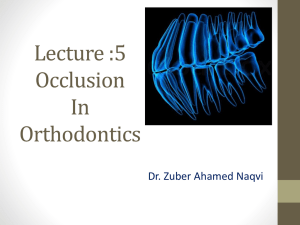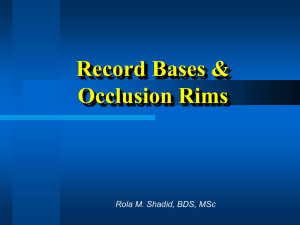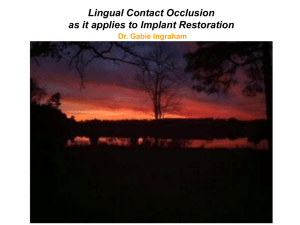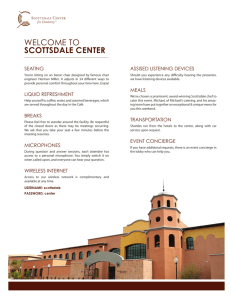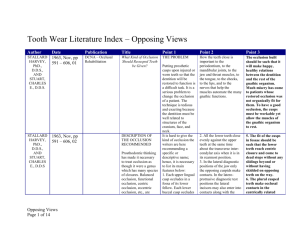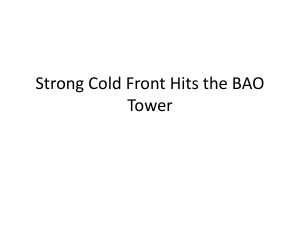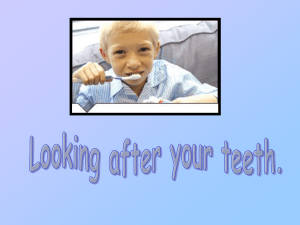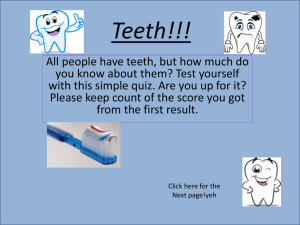CD_files/15. Set Posterior Teeth Ling & Monopl
advertisement
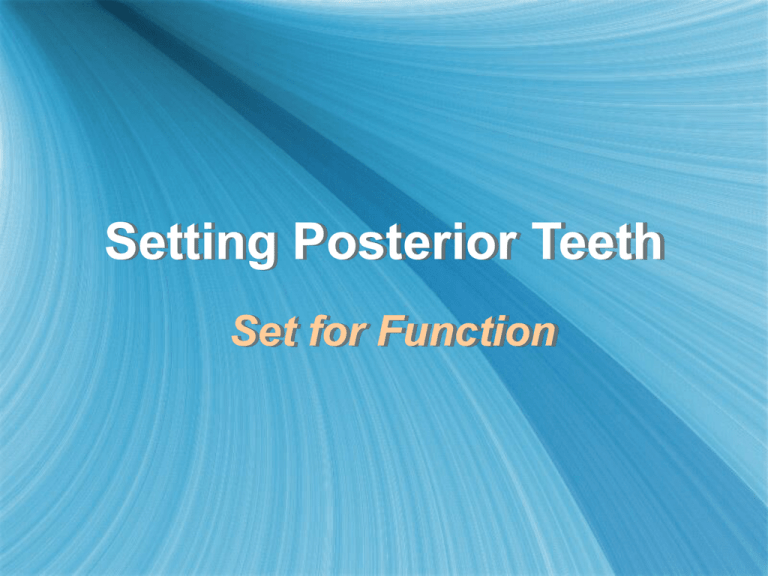
Setting Posterior Teeth Set for Function Philosophies of Denture Occlusion Many philosophies of arranging denture occlusion No definitive scientific studies prove one occlusal scheme clearly superior Rationale for Dalhousie Approach Principals to choose an occlusal scheme Based on clinical experience Dalhousie: two occlusal schemes : • Lingualized Occlusion • Monoplane Occlusion Occlusal Schemes Attempts to Stabilize Dentures Lingualized Occlusion: Contacts on centered on mandibular ridge minimizes movement Monoplane Occlusion: Lack of cusps minimizes lateral forces on denture Lingualized Occlusion Centric contacts are maxillary lingual cusp to central fossa / marginal ridge Based on the UCLA/IVOCLAR/ACP Series Lingualized Occlusion Anatomic teeth used in maxilla Better esthetics than Monoplane Shallow cusped mandibular teeth Forces centered over mandibular ridge Lingualized Occlusion No overbite May or may not have balancing contacts in excursions Anterior teeth - must make at least grazing contacts in excursions Lingualized Occlusion Maxillary anatomic (33°) Mandibular Teeth Steep Condylar Guidance Shallow cusped (Anatoline) Shallow Condylar Guidance Non-anatomic (Portrait 0°) Denture Occlusion Options Semi-anatomic Non-anatomic (balancing ramp) Lingualized (lingual contact) Anatomic Nonanatomic Occlusal plane Set mandibular premolars & 1st molar : • Level with occl plane • Centered over ridge Line indicating the crest of the ridge Balanced Lingualized Occlusion Maxillary anatomic opposing Mandibular shallow cusp If using a lingualized posterior tooth form (Dentsply Anatoline) • little or no Curve of Wilson • lingual and buccal cusps of level with plane of occlusion 15 degrees Second molar elevated by ~ 15 ° from the occlusal plane Max. lingual cusps contact central fossae/marginal ridge ~ 1mm space between buccal cusps Maxillary lingual cusps firmly contact bilaterally simultaneously Centric Position Verify centric No max. buccal cusp contacts in: • Centric • Lateral excursions Working Excursions Verify excursive contacts Anterior teeth are in contact during lateral excursions Balancing Excursions Note the balancing contacts Effect of Mandible Moving Downward During Excursions QuickTime™ and a Motion JPEG OpenDML decompressor are needed to see this picture. Maintaining Balancing Contacts Change occlusal plane angle Increase compensating curves Increase cusp angles Achieving Balance • Condylar angulation Recorded with protrusive record • Cusp angle Selected by dentist Achieving Balance • Occlusal Plane Determined by dentist with wax rims • Curve of Spee & Curve of Wilson Controlled by inclination of teeth Checking for Balance Feels Smooooooth in excursions - Fingers on Maxillary Canines - On Articulator Assessing Balance • Jumps or bumps are due to cusp tips moving over other cusp tips, inclines, marginal ridges Occlusal Refinement Occlusal Adjustment, Selective Grinding Set teeth as close to: Maximum intercuspation Balance All setups will need some adjustment ‘IIF’ Rule IIF you have contacts on the Inner Inclines of Functional cusps they are balancing contacts B L B Working Contacts L Inner Inclines (inside of cusp) Outer Inclines(outside of cusp) Find the Balancing Contact Find the Balancing Contact What type of Contact? What type of Contact? What type of Contacts? What type of Contact? Assess Contacts Centric Stops Excursions Non-Balanced Lingualized Occlusion Maxillary anatomic opposing mandibular non-anatomic Mortar & pestle occlusion without maxillary buccal cusp contact Lack of mandibular cusp angles and no attempt to balance the occlusion No compensating curves No overbite No overbite Magnitude of Overjet Class I More for Class II patients Class II Magnitude of Horizontal Overlap Class III Class III patients Little or no overjet Setting the posterior teeth • Teeth should end prior to the ascending ramus • Maxillary lingual cusps contact central groove/marginal ridge of the opposing teeth The horizontal overlap should be ideal and should be sufficient to prevent biting of the cheek and corner of the mouth Horizontal overlap • All maxillary teeth, with the exception of the lateral incisors and cuspids, should be on the plane of occlusion Monoplane Occlusion Monoplane Occlusion Cuspless teeth (0°) on a flat plane with 1.5-2.0 mm overjet No cusp to fossa relationship No anterior contacts in centric position Monoplane Occlusion Eliminate cusps lateral forces reduced improves stability Simplifies tooth arrangement Monoplane Occlusion No overbite (would cause tilting) Overjet of 2 mm is used to create an illusion of overbite Monoplane Occlusion Excursions - may or may not contact on balancing sides Depends on condylar inclination and other aspects of the tooth arrangement Monoplane Occlusion Anterior teeth make contact in excursions Modifications have been proposed to minimize the tilting potential: Balancing ramps Compensating curves Monoplane Occlusion without condylar influence Monoplane Occlusion Monoplane Occlusion Advantages • Technically easier to achieve • Use when: – Difficulty obtaining repeatable centric records (muscle incoordination) – Skeletal malocclusion (Class II, III) – Severe residual ridge resorption – Reduces horizontal forces Monoplane Occlusion Disadvantages • Poorer appearance • Can be unstable if condylar guidance is steep (posterior teeth separate, leaving only the anteriors in contact) Monoplane Occlusion Clinical remount on an articulator Practice doing a clinical remount Adjusting Monoplane Occlusion Main adjustment is flat If heavy prematurity near fossa, slightly shallow fossa
